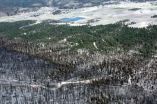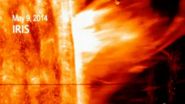(Press-News.org) Boston, MA – The tangled highway of blood vessels that twists and turns inside our bodies, delivering essential nutrients and disposing of hazardous waste to keep our organs working properly has been a conundrum for scientists trying to make artificial vessels from scratch. Now a team from Brigham and Women's Hospital (BWH) has made headway in fabricating blood vessels using a three-dimensional (3D) bioprinting technique.
The study is published online this month in Lab on a Chip.
"Engineers have made incredible strides in making complex artificial tissues such as those of the heart, liver and lungs," said senior study author, Ali Khademhosseini, PhD, biomedical engineer, and director of the BWH Biomaterials Innovation Research Center. "However, creating artificial blood vessels remains a critical challenge in tissue engineering. We've attempted to address this challenge by offering a unique strategy for vascularization of hydrogel constructs that combine advances in 3D bioprinting technology and biomaterials."
The researchers first used a 3D bioprinter to make an agarose (naturally derived sugar-based molecule) fiber template to serve as the mold for the blood vessels. They then covered the mold with a gelatin-like substance called hydrogel, forming a cast over the mold which was then reinforced via photocrosslinks.
"Our approach involves the printing of agarose fibers that become the blood vessel channels. But what is unique about our approach is that the fiber templates we printed are strong enough that we can physically remove them to make the channels," said Khademhosseini. "This prevents having to dissolve these template layers, which may not be so good for the cells that are entrapped in the surrounding gel."
Khademhosseini and his team were able to construct microchannel networks exhibiting various architectural features. They were also able to successfully embed these functional and perfusable microchannels inside a wide range of commonly used hydrogels, such as methacrylated gelatin or poly(ethylene glycol)-based hydrogels at different concentrations.
Methacrylated gelatin laden with cells, in particular, was used to show how their fabricated vascular networks functioned to improve mass transport, cellular viability and cellular differentiation. Moreover, successful formation of endothelial monolayers within the fabricated channels was achieved.
"In the future, 3D printing technology may be used to develop transplantable tissues customized to each patient's needs or be used outside the body to develop drugs that are safe and effective," said Khademhosseini.
INFORMATION:
This research was supported by the National Institutes of Health (AR057837, DE021468, HL099073, AI081534, EB02597, GM095906), Presidential Early Career Award for Scientists and Engineers, Defense Threat Reduction Agency, and Australian Research Council.
Brigham and Women's Hospital (BWH) is a 793-bed nonprofit teaching affiliate of Harvard Medical School and a founding member of Partners HealthCare. BWH has more than 3.5 million annual patient visits, is the largest birthing center in Massachusetts and employs nearly 15,000 people. The Brigham's medical preeminence dates back to 1832, and today that rich history in clinical care is coupled with its national leadership in patient care, quality improvement and patient safety initiatives, and its dedication to research, innovation, community engagement and educating and training the next generation of health care professionals. Through investigation and discovery conducted at its Brigham Research Institute (BRI), BWH is an international leader in basic, clinical and translational research on human diseases, more than 1,000 physician-investigators and renowned biomedical scientists and faculty supported by nearly $650 million in funding. For the last 25 years, BWH ranked second in research funding from the National Institutes of Health (NIH) among independent hospitals. BWH continually pushes the boundaries of medicine, including building on its legacy in transplantation by performing a partial face transplant in 2009 and the nation's first full face transplant in 2011. BWH is also home to major landmark epidemiologic population studies, including the Nurses' and Physicians' Health Studies and the Women's Health Initiative. For more information, resources and to follow us on social media, please visit BWH's online newsroom.
Building a better blood vessel
Scientists use 3D printing to successfully address the ongoing challenge of making artificial blood vessels
2014-05-30
ELSE PRESS RELEASES FROM THIS DATE:
Eradicating invasive species sometimes threatens endangered ones
2014-05-30
What should resource managers do when the eradication of an invasive species threatens an endangered one?
In results of a study published this week in the journal Science, researchers at the University of California, Davis, examine one such conundrum now taking place in San Francisco Bay.
The study was led by UC Davis researcher Adam Lampert.
"This work advances a framework for cost-effective management solutions to the conflict between removing invasive species and conserving biodiversity," said Alan Tessier, acting deputy division director in the National Science ...
New NASA/JAXA precipitation satellite passes check-out, starts mission
2014-05-30
The new Global Precipitation Measurement Core Observatory satellite is now in the hands of the engineers who will fly the spacecraft and ensure the steady flow of data on rain and snow for the life of the mission. The official handover to the Earth Science Mission Operations team at NASA's Goddard Space Flight Center in Greenbelt, Maryland, on May 29, marked the end of a successful check-out period.
The Global Precipitation Measurement (GPM) mission is a joint mission between NASA and the Japan Aerospace Exploration Agency. Its Core Observatory launched on Feb. 27, 2014, ...
Wallow Fire study suggests there may be multiple paths to fuel reduction in the WUI
2014-05-30
Conservative fuel treatments designed to reduce fire severity while still providing forest cover and wildlife habitat worked equally as well as more intensive treatments in allowing for the protection of homes during the 2011 Wallow Fire, a study published in the journal Forest Ecology and Management has found. The distance into the treated area where fire severity was reduced varied, however, between these different thinning approaches where fuels were reduced. The findings suggest that there may be multiple paths to fuel treatment design around the wildland-urban interface ...
A first for NASA's IRIS: Observing a gigantic eruption of solar material
2014-05-30
VIDEO:
A coronal mass ejection burst off the side of the sun on May 9, 2014. The giant sheet of solar material erupting was the first CME seen by NASA's Interface...
Click here for more information.
A coronal mass ejection, or CME, surged off the side of the sun on May 9, 2014, and NASA's newest solar observatory caught it in extraordinary detail. This was the first CME observed by the Interface Region Imaging Spectrograph, or IRIS, which launched in June 2013 to peer into ...
Myriad presents data on BRACAnalysis CDx and HRD at 2014 ASCO meeting
2014-05-30
SALT LAKE CITY, Utah, May 30, 2014 – Myriad Genetics, Inc. (NASDAQ: MYGN), a global leader in molecular diagnostics, announced the presentation of new data at the American Society of Clinical Oncology (ASCO) meeting this week that supports the clinical efficacy of its BRACAnalysis CDx™ and HRD™ tests in predicting platinum based therapy response for breast cancer patients. Additionally, the company is providing an update on key commercial milestones that underscore its commitment to the field of companion diagnostics.
"Myriad is committed to advancing the science of companion ...
New method of wormlike motion lets gels wiggle through water
2014-05-30
Next time you spot an earthworm sliding through fresh dirt, take a closer look. What you're seeing is an organic movement called peristaltic locomotion that has been meticulously refined by nature.
Jarod Gregory, an undergraduate student in the University of Cincinnati's College of Engineering and Applied Science, used a worm's contracting and expanding motion to provide a way for gels to swim in water. This is a product of work by the interdisciplinary team consisting of Jarod Gregory, a chemical engineering major, and his two advisers, Lilit Yeghiazarian, assistant ...
New drug treatment helps prevent early menopause in breast cancer patients
2014-05-30
MAYWOOD, Ill. (May 30, 2014) – Among young women treated for breast cancer, one of the most distressing side effects of chemotherapy is early menopause. But a major clinical trial has found that the risk of early menopause can be significantly reduced by adding a drug called goserelin to the chemotherapy regimen. Also, women who took goserelin and wanted to have children were more likely to get pregnant and deliver a healthy baby.
Results were released during the 2014 American Society of Clinical Oncology 50th Annual Meeting in Chicago. Kathy Albain, MD, of Loyola University ...
Stopping statins may benefit terminally ill patients
2014-05-30
Results presented today at the 50th Annual Meeting of the American Society for Clinical Oncology (ASCO) and June 6 at the European Association of Palliative Care Research Conference show that stopping statins for cholesterol management in the late stages of cancer or other terminal illnesses may offer quality-of-life and even life-extending benefits. The results highlight the larger question of when, if ever, it is appropriate in patients with life-limiting illnesses to discontinue medications prescribed for other conditions that will likely not lead to their death.
Researchers ...
Women with metastatic breast cancer can safely receive bisphosphonates less frequently, without comp
2014-05-30
CHICAGO – Women with metastatic breast cancer to the bone may be able to receive bisphosphonates, the bone-targeting class of drugs like zoledronic acid, less often after the first year of monthly administration. With that practice change, women may also reduce their risk of serious side effects, according to a study led by researchers at The University of Texas MD Anderson Cancer Center.
The research was presented today on the press program of the American Society of Clinical Oncology 2014 Annual Meeting by MD Anderson's Gabriel Hortobagyi, MD, professor, Breast Medical ...
Phase I study of DMOT4039A in patients with pancreatic or ovarian cancer
2014-05-30
A study presented at the 50th Annual Meeting of the American Society for Clinical Oncology (ASCO) describes the results of a phase I clinical trial of the investigational agent DMOT4039A against pancreatic and ovarian cancers. In this early clinical trial with the goal of identifying possible risks and defining likely dosages, the drug was well tolerated and in some patients showed initial evidence of anti-cancer activity.
The drug is in fact a combination of a chemotherapeutic agent with an antibody, technically called an antibody-drug conjugate (ADC). Just as cells ...
LAST 30 PRESS RELEASES:
iPS cells from dish to freezer and back
Deep neural networks enable accurate pricing of American options under stochastic volatility
Collective risk resonance in Chinese stock sectors uncovered through higher-order network analysis
Does CPU impact systemic risk contributions of Chinese sectors? Evidence from mixed frequency methods with asymmetric tail long memory
General intelligence framework to predict virus adaptation based on a genome language model
Antibiotic resistance is ancient, ecological, and deeply connected to human activity, new review shows
Vapes, pouches, heated tobacco, shisha, cigarettes: nicotine in all forms is toxic to the heart and blood vessels
From powder to planet: University of Modena engineers forge a low-carbon future for advanced metal manufacturing
Super strain-resistant superconductors
Pre-school health programme does not improve children’s diet or physical activity, prompting call for policy changes, study finds
Autumn clock change linked to reduction in certain health conditions
AI images of doctors can exaggerate and reinforce existing stereotypes
Where medicine meets melody – how lullabies help babies and parents in intensive care
We may never be able to tell if AI becomes conscious, argues philosopher
AI video translation shows promise but humans still hold the edge
Deep ocean earthquakes drive Southern Ocean’s massive phytoplankton blooms, study finds
Without campus leftovers to pick through, the beaks of this bird changed shape during the pandemic
High-dose antibiotic does not reduce mortality in tuberculous meningitis
How many insects fly in the sky above the USA?
Could cheese protect your brain health?
Who faces more difficulty recovering from stroke?
Colliding galaxies create the brightest, fastest growing black holes at their center
New BrainHealth research reveals tradeoffs on sleep with cannabis use for chronic pain
Aging-US now on ResearchGate, enhancing visibility for authors and readers
'Molecular glue' stabilizes protein that inhibits development of non-small cell lung cancer
Mount Sinai Health System is recognized in 2025 Chime Digital Health Most Wired survey
From prey to predator: How carnivores spread beneficial fungi
Menopause symptoms may be frequent and have negative effects, according to female endurance athletes
US Congressmembers’ responses on X to mass shooting events differ along party lines
KAIST-UEL team develops “origami” airless wheel to explore lunar caves
[Press-News.org] Building a better blood vesselScientists use 3D printing to successfully address the ongoing challenge of making artificial blood vessels








